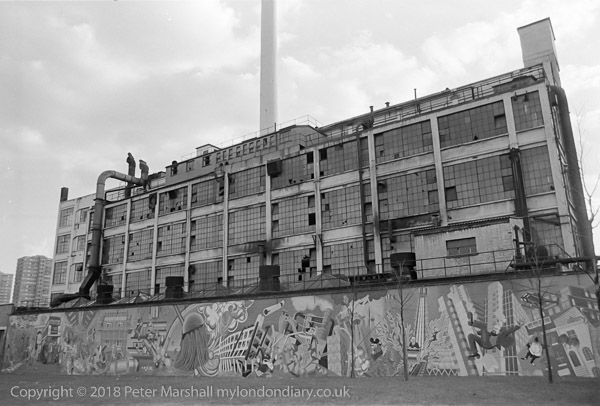London 1978
Peter MARSHALL

Mural and Morganite works, Battersea, Wandworth,
1978
14l42: wandsworth, battersea, works, mural
You can click on the image to go to the next picture
The Morgan Crucible Works between Church Road and the River Thames began with a company bought by William Morgan in 1850; he was joined by his five brothers in 1855 and in 1856 they bought the small crucible factory of E. Falcke & Sons, founded by Wilhelm Falcke around 1823, at Garden Wharf halfway between Battersea Bridge and St Mary's Church. The Morgans had been selling a crucible made in the USA which used graphite mixed into the clay and decided to make these themselves, setting up the Patent Plumbago Crucible Company (plumbago being a now archaic name for graphite.) In 1872 they bought up the surrounding houses and built a new factory with a 100ft clock tower, designed by Charles
Henry Cooke.
They continued to expand and buy up neighbouring wharves, eventually owning an around 1,000 ft stretch of the riverside, erecting more buildings on the expanded site. The building in my picture is I think their large factory building from 1934-7. By the 1960s the business had run out of space for further expansion and moved production to sites in Worcestershire and Swansea. The Battersea Works closed in 1970 and building of a housing estate on the site, Morgan's Walk by Wates Ltd, began shortly after I took this picture and was completed in 1984.
'The Battersea Mural: The Good, The Bad and the Ugly' on 'Morganís Wall' was designed by Brian Barnes in 1976 and painted with permission from Morgans by him and 60 local residents from the Battersea Redevelopment Action Group, taking nearly 2 years to complete. Scandalously an application to make the retention of the wall a condition of planning permission for demolition of the site was turned down and the 276-foot wide mural between 12 and 18 ft high was demolished when the Morgan Crucible Company brought in heavy plant at dead of night on 6th June 1979. The artist and six others were arrested at the site later in the day. Fortunately the mural, a vision of the future of the area, had been well recorded in photographs and on film, which you can see on YouTube.